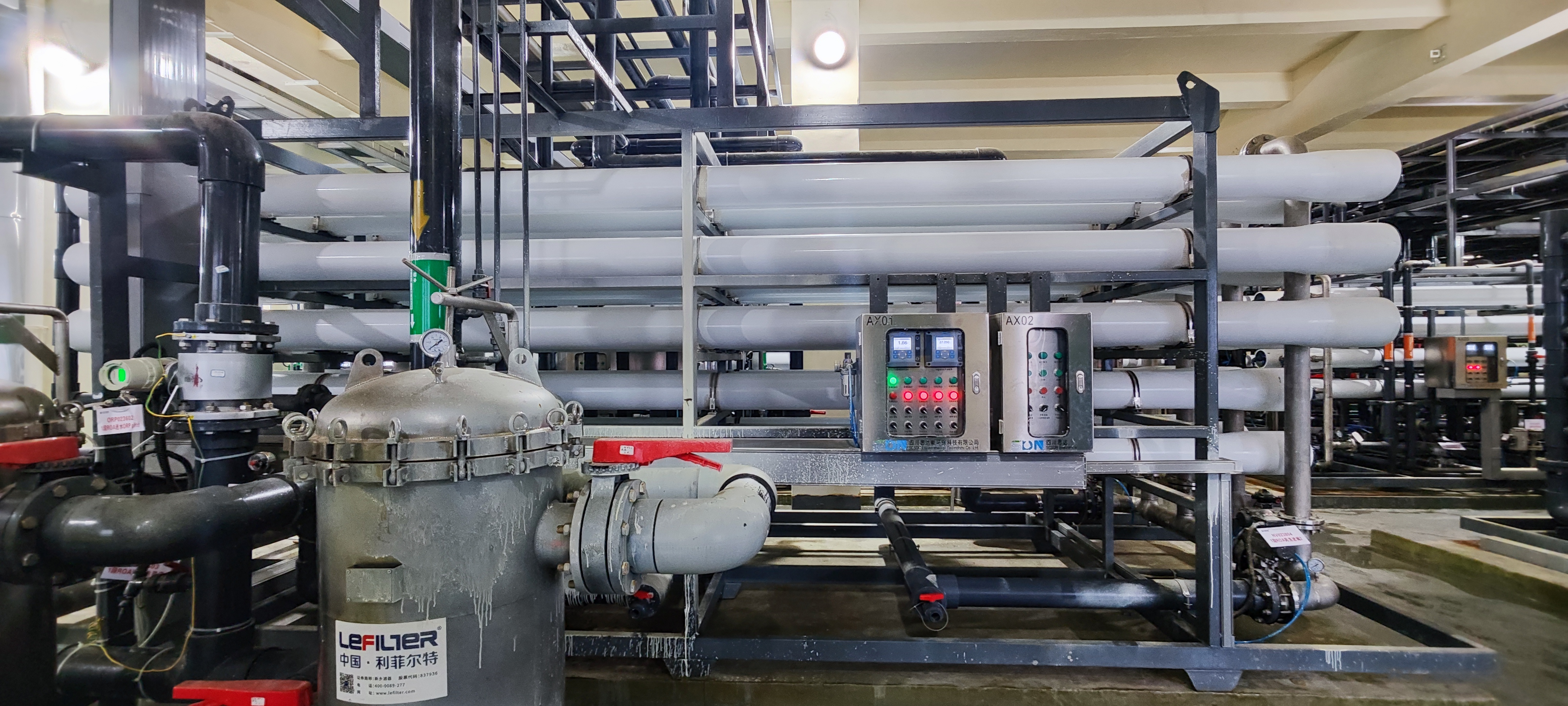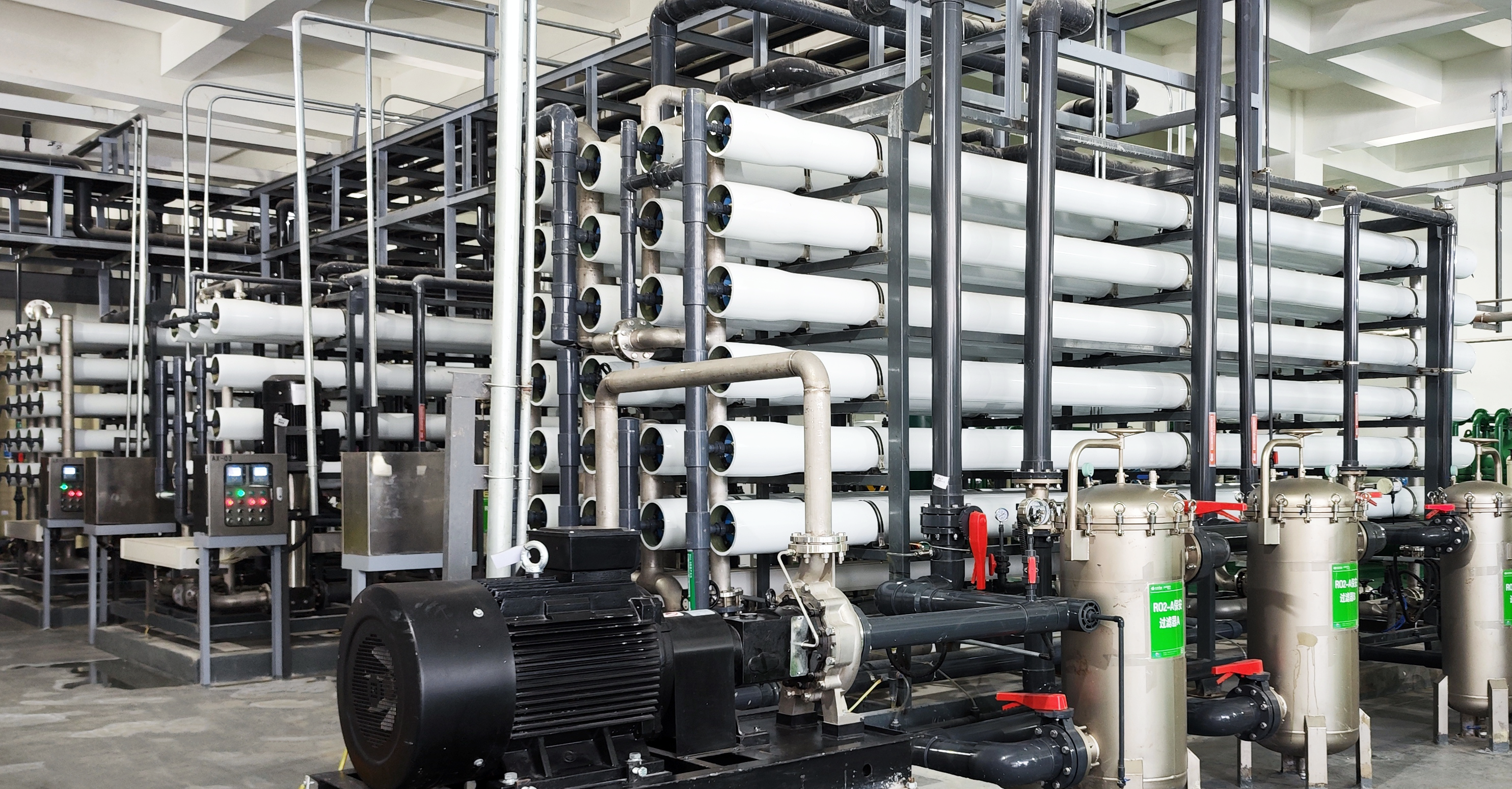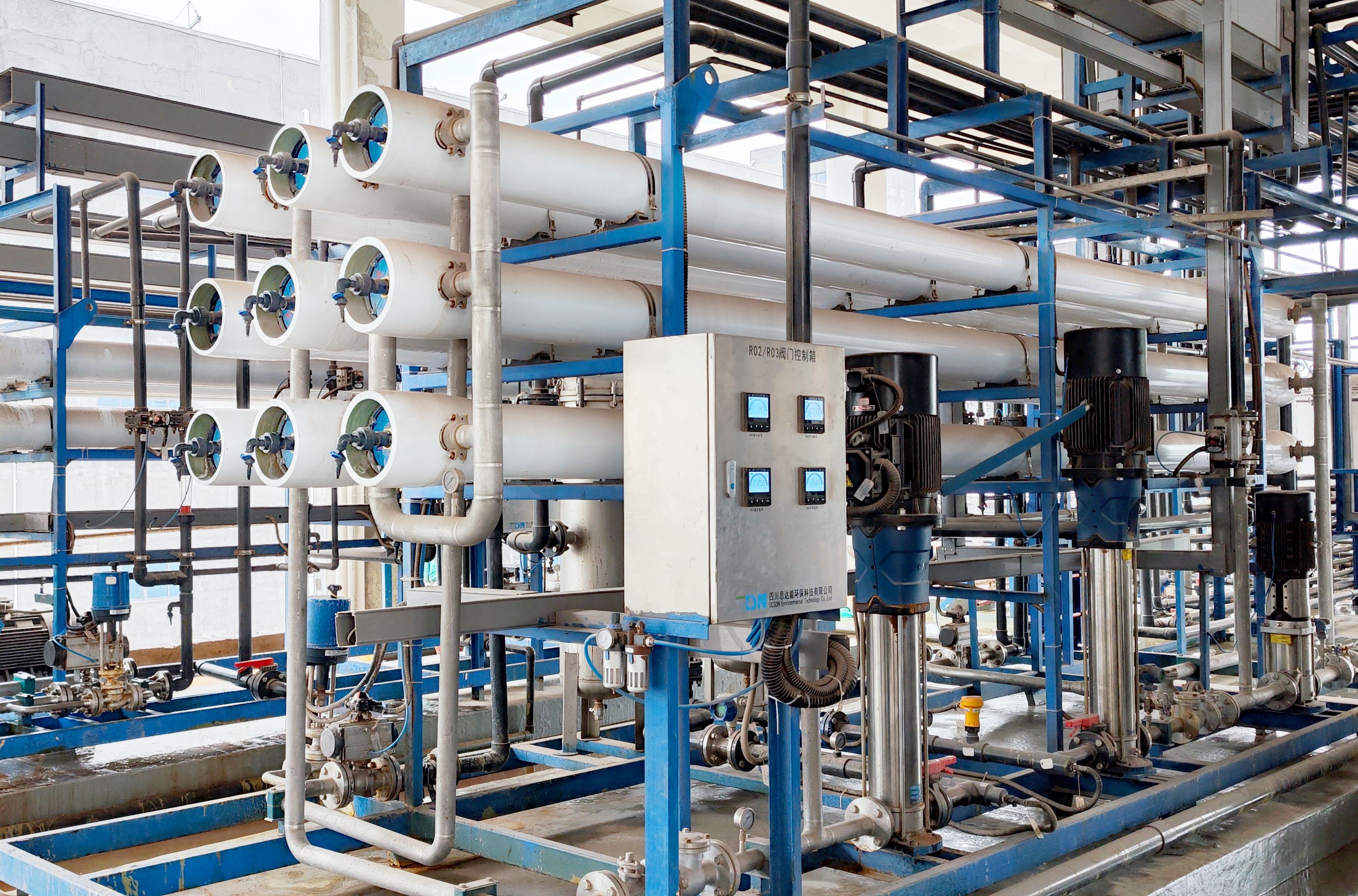1. Reverse osmosis membrane pollution
(1) reverse osmosis membrane performance damage, resulting in membrane pollution
① Polyester material reinforced non-woven fabric, about 120μm thick;
② polysulfone material porous intermediate support layer, about 40μm thick;
③ Ultra-thin separation layer of polyamide material, about 0.2μm thick.
According to its performance structure, such as permeable membrane performance damage may have the following reasons:
①The maintenance of the new reverse osmosis membrane is not standardized;
②If the maintenance meets the requirements, the storage time exceeds 1 year;
③ In the shutdown state, the reverse osmosis membrane maintenance is not standardized;
④ The ambient temperature is below 5℃;
⑤The system operates under high pressure;
⑥ Improper operation during shutdown.
(2)Water quality changes frequently, resulting in membrane pollution
The raw water quality changes with the design water quality, which increases the pretreatment load. Due to the increase of impurities such as inorganic matter, organic matter, microorganism, granular matter and colloids in the water, the probability of membrane pollution increases.

(3) Insufficient cleaning and cleaning method is not correct resulting in membrane pollution
In the process of use, in addition to the normal attenuation of the performance of the film, the incorrect cleaning method is also an important factor leading to serious membrane pollution.
(4) The dosage was not properly administered
In use, because the polyamide film has poor residual chlorine resistance, chlorine and other disinfectants are not correctly added in use, and the user does not pay enough attention to the prevention of microorganisms, it is easy to lead to microbial pollution.
(5) Film surface wear
Film surface wear The film element is blocked by foreign matter or the film surface is worn (such as sand, etc.), in this case, the detection method should be used to detect the components in the system, find the damaged components, transform the pre-treatment, and replace the film element.
2. The phenomenon of reverse osmosis membrane contamination
In the process of reverse osmosis operation, due to the selective permeability of the membrane, some solutes accumulate near the membrane surface, resulting in the phenomenon of membrane fouling. There are several common signs of fouling: One is biological fouling (symptoms gradually appear) Organic sediments are mainly living or dead microorganisms, hydrocarbon derivatives, natural organic polymers, and all carbon-containing materials. The initial manifestations are increased desalinization rate, increased pressure drop and decreased water production. Another is colloidal fouling (symptoms gradually appear) during the membrane separation process, the concentration of metal ions and the change in the PH value of the solution may be the deposition of metal hydroxide (mainly represented by Fe(OH)3), causing fouling. At first, the desalting rate decreased slightly, and gradually increased, and finally the pressure drop increased and the water production decreased. In addition, during the operation of the particle pollution reverse osmosis system, if there is a problem with the security filter, particles will enter the system, causing the particle pollution of the membrane.
At first, the flow rate of concentrated water increased, the desalting rate did not change much at the initial stage, the water production gradually decreased, and the system pressure drop increased quickly. Finally, chemical scaling is common (symptoms appear soon). When the water supply contains high Ca2+, Mg2+, HCO3-, CO32-, SO42- plasma, CaCO3, CaSO4, MgCO3 and other scales are deposited on the membrane surface. This is manifested by a decrease in the desalinization rate, especially in the final section, and a decrease in water production. Membrane pollution is the main reason for the decrease of membrane permeation flow. The membrane filtration resistance increases due to the blockage of pores and macromolecular solutes. Solute adsorbed on pore wall; The formation of a gel layer on the membrane surface increases the mass transfer resistance. The deposition of components in the membrane pore will cause the membrane pore to be reduced or even blocked, which actually reduces the effective area of the membrane. The additional resistance generated by the contamination layer deposited by the components on the surface of the film may be much greater than the resistance of the film itself, making the permeability flow independent of the permeability of the film itself. This effect is irreversible, and the degree of pollution is related to the concentration and properties of the membrane material, the solvent in the retention solution and the macromolecular solute, the pH value of the solution, the ionic strength, the charge composition, the temperature and the operating pressure, etc., which can reduce the membrane flux by more than 80% when the pollution is serious.
In the operation of the system, the pollution of the membrane is a very difficult problem, which causes the removal rate of the reverse osmosis device, the water permeability and the membrane flux to decrease significantly, while increasing the operating pressure of each section, promoting the operation and operating costs, and seriously affecting the service life of the membrane and the development and utilization of reverse osmosis technology.

3. solution
(1) Perfect pretreatment
For each set of membrane device, people want it to maximize its role, hoping to have the highest desalinization rate, the maximum water penetration and the longest life as possible, to achieve the above three points, water quality is crucial, so the raw water entering the membrane device must have good pretreatment. Reasonable pretreatment is very important for long term safe operation of reverse osmosis plant. With the pretreatment to meet the water quality requirements of the reverse osmosis influent, the water production flow can be maintained. The desalting rate is maintained at a certain value for a long time; Product water recovery rate can be unchanged; Minimum operating costs; Long membrane service life.
Specifically, reverse osmosis pretreatment is designed to:
①To prevent pollution on the surface of the film, that is, to prevent suspended impurities, microorganisms, colloidal substances, etc. from adhering to the surface of the film or fouling the water channel of the film element.
②Prevent scaling on the surface of the film. During the operation of the reverse osmosis device, some insoluble salts are deposited on the surface of the membrane due to the concentration of water, so the formation of these insoluble salts should be prevented.
③Ensure that the film is free from mechanical and chemical damage, so that the film has good performance and a long enough use time.
(2) The membrane is cleaned
Although the feed liquid has been treated with various pretreatment measures, the surface of the film may also produce deposition and scaling after long-term use, which will clog the membrane hole and reduce the water production, so it is necessary to clean the contaminated film regularly. However, the reverse osmosis membrane system can not wait until the pollution is very serious before cleaning, which will increase the difficulty of cleaning, but also increase the cleaning steps and prolong the cleaning time. It is necessary to grasp the cleaning time correctly and remove the dirt in time.
Cleaning principle:
Understand the local water quality characteristics, carry out chemical analysis of pollutants, and select the best cleaning agent and cleaning method through the analysis of the results, and provide the basis for finding the best method under the specific water supply conditions;
Cleaning conditions:
a. The amount of water produced is reduced by 5%-10% compared to normal.
b. In order to maintain the product water quantity, the water supply pressure after the temperature correction is increased by 10%-15%.
c. Increase the conductivity through water quality (increased salt content) by 5%-10%.
d. Multi-stage RO system, the pressure drop increases significantly through different stages.
Cleaning method:
First, the system recoil; Then the negative pressure cleaning; Mechanical cleaning if necessary; Then chemical cleaning; Conditions can be ultrasonic cleaning; Online electric field cleaning is a good method, but it is expensive; Because the chemical cleaning effect is better, the rest of the methods are not easy to achieve, and the drug provided by various suppliers is different in name and use, but its principle is roughly the same. For example, our company now uses membrane cleaning agents MC2 and MA10.
The cleaning steps are as follows:
Cleaning single stage system:
① Configure cleaning solution;
② Low flow input cleaning solution;
③ Cycle;
④ Soaking;
⑤ High flow pump circulation;
⑥ Rinse;
⑦ Restart the system.
Cleaning for special pollutants are: cleaning sulfate scale, cleaning carbonate scale, cleaning iron and manganese pollution, cleaning organic pollution.

(3) Proper maintenance of the membrane
New RO membrane maintenance New RO membrane elements are usually soaked with 1%NaHSO3 and 18% glycerol solution and stored in sealed plastic bags. In the case that the plastic bag is not broken, it is stored for about 1 year, and it will not affect its life and performance. When the plastic bag is opened, it should be used as soon as possible to avoid adverse effects on the components due to the oxidation of NaHSO3 in the air. Therefore, the membrane should be opened as far as possible before use. In the non-production period, the maintenance of reverse osmosis system is a more important issue. This can be done as follows.
①The system is shut down for a short period of time (1-3 days) : Before the shutdown, the system is washed with low pressure (0.2-0.4MPa) and large flow (about equal to the water production of the system) for 14 to 16 minutes; Maintain the usual natural flow and let the water flow into the thick channel.
②The system is out of service for more than a week (the ambient temperature is above 5 ° C) : before the shutdown, the system is carried out at low pressure (0.2-0.4MPa), and the large flow rate (about equal to the system's water production (washing, the time is 14 to 16 minutes; Chemical cleaning is carried out according to the method of chemical cleaning of the system in the reverse osmosis system operating instructions; After chemical cleaning, rinse the reverse osmosis membrane; Prepare 0.5% formalin solution, input it into the system at low pressure and circulate for 10 minutes; Close the valves of all systems and seal them; If the system is out of service for more than 10 days, the formalin solution must be replaced every 10 days.
③The ambient temperature is below 5 ° C: before shutdown, the system is washed with low pressure (0.2-0.4MPa) and large flow rate (about equal to the water production of the system) for 14 to 16 minutes; In the place where conditions exist, the ambient temperature can be increased to more than 5 ° C, and then according to the method of 1, system maintenance; If the ambient temperature is unconditionally raised, the water with a low pressure (0.1MPa) and a flow rate of 1/3 of the water produced by the system will flow for a long time to prevent the reverse osmosis membrane from freezing and ensure that the system runs for 2 hours a day; According to the methods of (2) and (3) in 1, after cleaning the reverse osmosis membrane, remove the reverse osmosis membrane, move it to a place where the ambient temperature is greater than 5 ° C, soak it in the prepared 0.5% formalin solution, turn it over every two days, and the water in the system pipe should be discharged clean to prevent damage to the system caused by icing.
(4) Avoid membrane operation under high pressure
When the system starts and stops, residual gas remains, making the system operate under high pressure. The pressure gauges at the front and back of the filter are used to monitor the pressure drop of the filter element, while the primary and final pressure gauges are used to monitor the pressure drop of the RO membrane assembly. Adjust intake valve and concentration valve to ensure operating pressure and recovery rate. If the water flow or total flow rate drops during operation, or the pressure difference between the primary and intermediate levels increases significantly compared to the initial operation of the pressure difference (based on the initial operation of the new reverse osmosis membrane component data), the system needs to be flushed or cleaned to ensure the safety of the membrane component performance.
①After the equipment is emptied, when it is re-run, the gas is not exhausted and the pressure is quickly boosted. The remaining air should be drained under the pressure of the system, and then gradually increase the pressure operation.
② When the joint between the pretreatment equipment and the high pressure pump is not sealed or leaked (especially the micron filter and the pipeline leakage after it), when the pre-treatment water supply is not enough, such as the micron filter is blocked, some air will be sucked into the vacuum in the place where the seal is not good. The micron filter should be cleaned or replaced to ensure that the pipeline does not leak.
③Whether the operation of each running pump is normal, whether the flow rate is the same as the specified value, and compared with the pump operating curve to determine the operating pressure.
(5) Pay attention to the operation during shutdown
① Rapid depressurization without thorough flushing when shutdown. Because the concentration of inorganic salts in the concentrated water side of the film is higher than that of raw water, it is easy to scale and pollute the film. When ready to shut down, gradually reduce the pressure to about 3bar and rinse with pre-treated water for 14 to 16 minutes.
② When preparing to shut down, adding chemical reagents will cause the agent to remain in the membrane and the membrane shell, causing membrane pollution and affecting the service life of the membrane. The dosing should be stopped.






